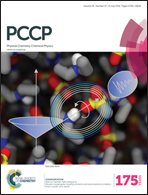Assembling a bi-coordinated Cr complex for ferromagnetic nanorings: insight from first-principles calculations†
Abstract
Motivated by the recent synthesis of bi-coordinated transition metal–organic complexes [Samuel, et al., Chem. Sci., 2015, 6, 3148], we have studied the structure and magnetic properties of a series of bi-coordinated transition metal based nanorings by folding quasi-1D chains. Among the cyclic alkyl(amino)carbine (CAAC) based quasi-1D chains (TM-CAAC, TM = Cr, Mn, Fe, Co, Ni), only Cr-CAAC is found to be ferromagnetic. First-principles calculations combined with Heisenberg–Dirac–van Vleck models were performed to understand the onset of robust ferromagnetism in Cr-based systems. With increasing size, the infrared intensity increases and the exchange energy oscillates. In particular, when the number, n, of TM-CAAC units is even and larger than 3, the magnetic coupling in nanorings is stronger than that in quasi-1D chains. The band gap changes very slowly with size. More importantly, compared with the highly coordinated Cr single molecular magnets, the low coordination of Cr ions enhances magnetic moment and stabilizes ferromagnetic coupling.


 Please wait while we load your content...
Please wait while we load your content...